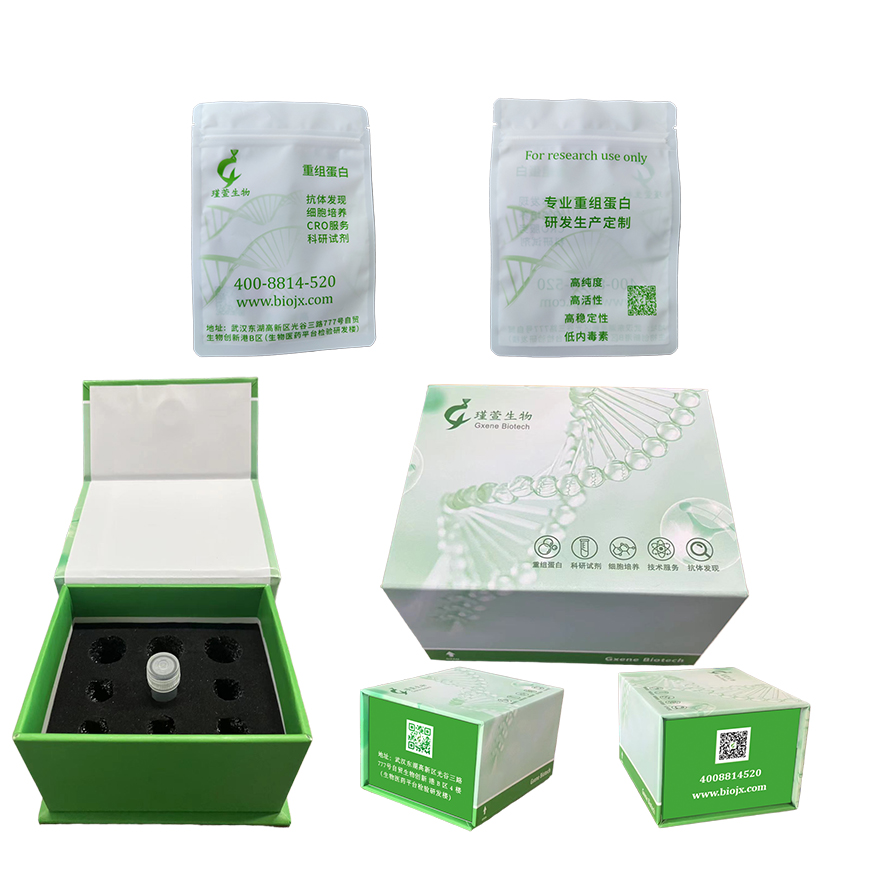研究方向
PDGF-DD是PDGF家族的一员,特异性结合并激活其同源受体PDGFR-β,通过激活下游多种致癌途径参与调节癌症的增殖、转化和侵袭,从而导致肿瘤的发生和进展.
-
种属Human表达宿主HEK293 cellsCalculated MW82.86 kDaObserved MW110-140标签C-hFc&His纯度> 90% by SDS-PAGE.内毒素< 0.1 EU/μg of the protein by LAL method.制剂Lyophilized from a 0.22 μm filtered solution of PBS, pH 7.4.Contact us for customized product form or formulation.描述Recombinant Human PDGFR-beta/CD140b(E241D) Protein is produced by HEK293 expression system. The target protein is expressed with sequence (Leu33-Phe530 (Glu241Asp)) of human PDGFRB/CD140b (Accession #NP_002600.1) fused with an Fc, 6×His tag at the C-terminus.储存Store at -20℃.Store the lyophilized protein at -20℃ to -80 ℃ up to 1 year from the date of receipt.
After reconstitution, the protein solution is stable at -20℃ for 3 months, at 2-8℃ for up to 1 week.未开盖的干粉蛋白在 -20°C至-80°C可保存12个月;
复溶之后,蛋白溶液在-20°C及以下可保存3个月,在2-8℃可保存1周。生物活性Measured by its binding ability in a functional ELISA. Immobilized recombinant Human PDGF-B at 2 μg/mL (100 μL/well) can bind recombinant Human PDGFRB. The EC50 of Human PDGFRB is 30.48 ng/mL.
复溶Centrifuge the vial before opening. Reconstitute to a concentration of 0.1-0.5 mg/mL in sterile distilled water. Avoid vortex or vigorously pipetting the protein. For long term storage, it is recommended to add a carrier protein or stablizer (e.g. 0.1% BSA, 5% HSA, 10% FBS or 5% Trehalose), and aliquot the reconstituted protein solution to minimize free-thaw cycles.收到重组蛋白产品之后请检查蛋白冻干粉末是否贴于瓶底,如果粉末浮起,开盖之前请先低温离心。将蛋白用说明书中指定的缓冲液复溶至0.1-0.5 mg/mL(请注意蛋白复溶浓度不能低于0.1 mg/mL),室温平衡5-10 min保证充分溶解,复溶过程中请不要剧烈涡旋及吹打蛋白溶液。如需长期储存,建议复溶时添加载体蛋白或者稳定剂(如0.1% BSA, 5% HSA, 10% FBS 或者 5% 海藻糖),同时将复溶后的蛋白溶液按照需求进行分装,储存于-20°C至-80°C,随取随用,避免反复冻融。背景信息
The protein is a cell surface tyrosine kinase receptor for members of the platelet-derived growth factor family. These growth factors are mitogens for cells of mesenchymal origin. The identity of the growth factor bound to a receptor monomer determines whether the functional receptor is a homodimer or a heterodimer, composed of both platelet-derived growth factor receptor alpha and beta polypeptides. This gene is flanked on chromosome 5 by the genes for granulocyte-macrophage colony-stimulating factor and macrophage-colony stimulating factor receptor; all three genes may be implicated in the 5-q syndrome. A translocation between chromosomes 5 and 12, that fuses this gene to that of the translocation, ETV6, leukemia gene, results in chronic myeloproliferative disorder with eosinophilia.

